Contacts:
Abbey Goers, Marketing Communications, 715-232-2565
Marketing Communications, 715-232-2381
News Center
Stout Core Ichthyology course gives students new perspectives on diversity of fish species in Wisconsin
MENOMONIE, Wis. (August 21, 2024) – The waves of Gitche Gumee roll high this afternoon. Churning brown crests surge and crash onto the beach at Wisconsin Point on Lake Superior, dragging large hunks of driftwood up and down the sand. The size of the waves is heightened as freighter ships cruise by.
The Great Lake calls to a group of 15 University of Wisconsin-Stout students, even as the cold spray clings to their faces and water threatens to fill their waders.
They’ve been waiting for this – “Fish Camp,” – their affectionate name for the fourth and final week of the hybrid summer Ichthyology course, where they’re learning about fish biology and the diversity of species in Wisconsin.
For the first three weeks of the course, Professor Mike Bessert provides his students with online video introductions about fish species, methods of research and regional relevance.
Follow the students’ experiences in a photo essay.
Their goal is to become familiar with the major families of fishes represented in the state; deepen their knowledge of the taxonomy, anatomy, physiology, behavior and ecology of fishes; and learn the impact of the fisheries industry and its management efforts.
“We are fortunate in Wisconsin to be located at the interface of a wide variety of aquatic systems – clear, cold streams of the Driftless Area, slow-moving marshes and wetlands, northern bogs, two of the Great Lakes and, of course, the St. Croix and Mississippi River main stems – home to more than 150 species of native freshwater fishes, as well as an increasing number of invasive species, such as round gobies and bighead carp,” explained Bessert, who designed the course 15 years ago.
The course is open to undergraduates as a part of Stout Core, foundational general education classes at Wisconsin’s Polytechnic University. Through Stout Core, students gain skills in natural sciences, communication, analytic and ethical reasoning, social responsibility and more, so they graduate ready to do more on day one.
The natural sciences – astronomy, geology, biology, chemistry and physics – requirement aims to introduce students to the sciences of the physical world and its phenomena.
The course applies well to Brinley Tonn’s environmental science major and concentration in environmental health.
“It seemed like a fun course to take to expand my knowledge on something that not a lot of people are aware of,” said Tonn, of Maple, Wis., just 10 miles from Lake Superior. “It was a very exciting week, and I was shocked at how fast it went by. I would recommend it to anyone who is interested.”
The “Fish Camp” home base is Hunt Hill Audubon Sanctuary, a nature preserve and learning center near Sarona, 70 miles north of UW-Stout and another 70 miles to Lake Superior.
They spend time fishing from canoes and kayaks on a local chain of lakes, collecting and studying fish on site, including observing spawning sunfish species.
They visit a gushing waterfall flooded by heavy summer rains and travel to various fish-related destinations, including the Iron River National Fish Hatchery, and Everett’s Fisheries, a fish processing business in Port Wing owned by the family of one of Bessert’s former students.
One early foggy morning, the group leaves Hunt Hill and heads to the Great Lakes Aquarium in Duluth, Minn. Bessert is friends with the aquarium director, who gives the students a behind-the-scenes tour.
They then head back across the two-mile-long Bong Memorial Bridge to Wisconsin Point, a peninsula off the shore of Superior. Located within the Lake Superior National Estuarine Research Reserve, the point is part of the world’s largest freshwater bay mouth sand bar.
The students pile out of their vehicles, pull on their waders and head down to the shore. They help Bessert into his fitted drysuit, which will keep him warmer as he wades out past his chest to draw out the arc of the 100-foot-long seine – a fishing net with weights on the bottom and floats on top to keep it upright.
The students stay nearer to shore, wading up to their waists to bring the seine out, using long walking sticks they find on the beach to test the water’s depth with each step.
As waves kick up the surf, the net catches more bits of driftwood than fish at first. The wind picks up inland as well and blows through the bogs. It drives an unexpected visitor to the lakeshore.
Terry Mortier, a retired metal worker from Hudson, travels around the state photographing its natural wonders. He is photographing indigenous butterfly species that inhabit the bogs, when it starts to be too windy, cloudy and cold for butterflying.
“You could say the weather drew, or more accurately drove me to the lake,” said Mortier, who joins the class for a few hours and captures their experience on camera.
Vivid memories of family smelting adventures as a kid come to mind as Mortier watches the students pull in the first couple runs with the seine.
“I was drawn into the excitement and couldn’t wait to see what was in the seine as it was being pulled to shore. The excitement of that last part of the pull as the net is closing and the fish are starting to bump – it was apparent on the students’ faces. It was contagious,” he said.
The students draw in the seine, and Bessert pulls up an eight-pound, two-foot-long redhorse, a native species of sucker – the largest fish they catch. They take turns taking photos with the redhorse and feel its natural slick sliminess and sheer strength as it wrestles to free itself from their grasp before they release it back to the water.
In another draw of the net, they bring up a black crappie, several invasive gobies and a black bullhead catfish.
“I was super excited that we caught the catfish, as this was the species I wrote my life history paper on for a class assignment,” said Jay Tie, a video production student from Lakeville, Minn. “As my peers were busy working on trying to catch more fish, I spent time looking at the catfish.
“I later found out from my classmates that bullheads have venom in spines on their fins and can sting you. Looking back at this photo and seeing where this fish’s fins are touching my hand, I’m grateful that it didn’t decide to hurt me,” he said.
On another day, the water is calm on Allouez Bay along Wisconsin Point and reflects the blue sky above, towering pines and sandstone shore. They wade up to their chests to drag smaller seines out from shore and take turns carrying smaller handheld nets and a shocker backpack for electrofishing.
The backpack is connected to an insulated six-foot wand, which the wearer uses to sweep the water and send an electric current to temporarily paralyze fish, allowing other students – protected from the current by their waders – to net, gather and observe species that rise to the surface before being released.
It is a method frequently used by the Department of Natural Resources during fish surveys and population counts.
They explore the biodiversity in a bog, where spring peeper frogs call and ferns and marsh grasses rustle in the breeze. Entering the bog, their boots are sucked down into the soft mud as they trudge through the shallows with the shocker and nets, using their arms for balance.
Classmates observe from a wooden bridge just feet above.
Back at Hunt Hill, in the hands-on lab, they refer to a dichotomous key, live fish and preserved fish specimens to identify unknown species.
“I took part in this course because I’ve always loved fish. It was an amazing experience getting to know the field and gave me a whole new perspective,” said Jake Swanson, an applied mathematics and computer science major from Eden Prairie, Minn.
“It’s hard work, but everyone worked together and used our resources to identify the 10 different fish that we caught during the day. It took hours, but it was such a fun time debating over what type of fish we were looking at,” he added.
Swanson would like to focus on aquatic biology and use his mathematics and computer skills to analyze fish.
Students also examine fish scales under a microscope to identify species.
“We looked at some of the smallest details to better understand our fish – counting the number of rays on a fin or the scales from the head to the tail of a fish,” Tie said. “While tedious, these labs were great bonding moments, with many debates over if a fish was yet another yellow perch or laughing as Professor Bessert started to doze off in the corner once the clock hit 10 p.m.”
Tie appreciates how welcoming Bessert is, especially to those unfamiliar with the field, as Tie came into the class with no knowledge of fish. Tie was excited at the opportunity to spend a week outdoors but was nervous about his lack of experience.
“Even with my lack of experience, I found myself waist-deep in waders trying to help catch fish with a giant net and using the shocker. My friend and I only ended up catching one fish about the size of my hand, but to a video production and graphic design student, it was a huge win,” Tie said.
“There were so many things that I enjoyed during the field experience,” he added. “I haven’t had many opportunities to work this closely with students in other majors. I got to meet so many people I wouldn’t have otherwise run into. It offered me an opportunity into a space that I otherwise felt I didn’t belong. I’m not the type of person to go out fishing even though I do like the outdoors.”
One of Tie’s favorite moments with Bessert was studying for the final in the Hunt Hill lab. Tie and his friends were visiting stations around the room, pointing to different fish and trying to remember their scientific family names.
“Professor Bessert joined in our excitement, shouting ‘Yes!’ while we recalled information we had been learning over the week,” he said.
Other ichthyology students are:
- Allison Bolterman, environmental science, Champlin, Minn.
- Miguel Heegeman, industrial design, Marshfield
- Oliver Hinds, animation and digital media, Maple Grove, Minn.
- Elias Jeska, environmental science, Somerset
- Lyndsey Krist, video production, Oak Creek
- Paulette Lambert, environmental science, St. Paul
- Ben McDonald, environmental science, Circle Pines, Minn.
- Zack McFadden, graphic design and interactive media, Lakeville, Minn.
- Theresa Stanislaw, applied science, Menomonie
- Amanda Valest, applied science, Warrens
- Brianna Wallin, human development and family studies, Caledonia, Minn.
- Trev Wood, environmental science, St. Paul
“It was nice meeting Michael and his students,” Mortier said. “He certainly gave them an experience they will remember. I’m sure the challenging weather and turbulent lake, combined with the excitement of collecting specimens and the camaraderie of the field trip, provided the students with an experience far beyond that of a classroom. Memories that will last them a lifetime.”
-30-
UW-Stout, a member of the Universities of Wisconsin, is Wisconsin’s Polytechnic University, with a focus on applied learning, collaboration with business and industry, and career outcomes. Learn more via the FOCUS2030 strategic plan.
To download full image, right-click and choose “save image as”
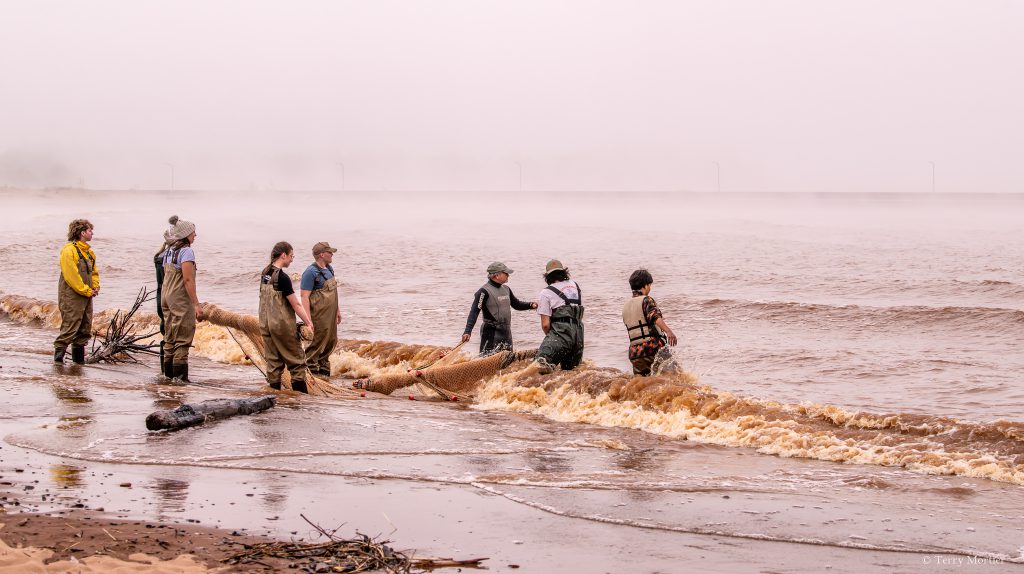
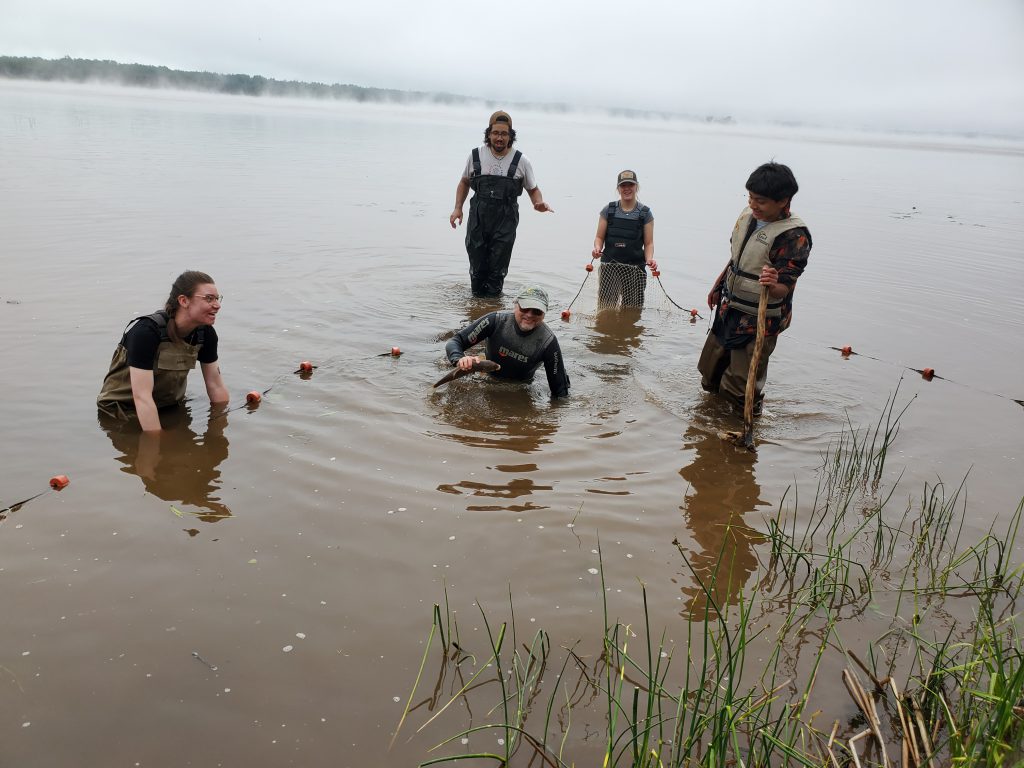
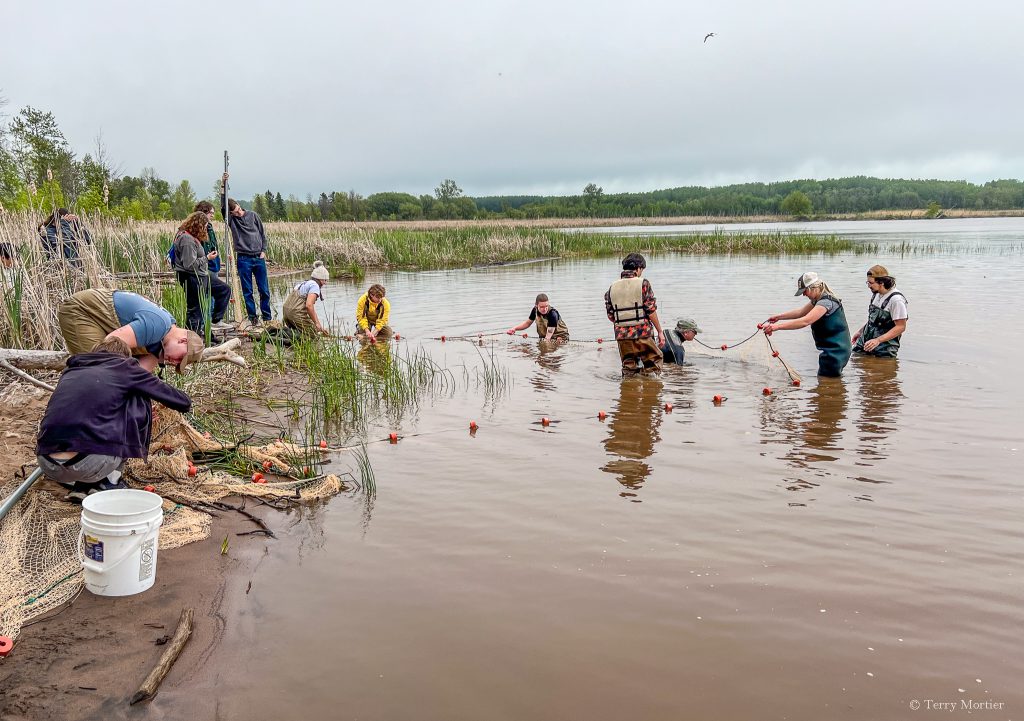
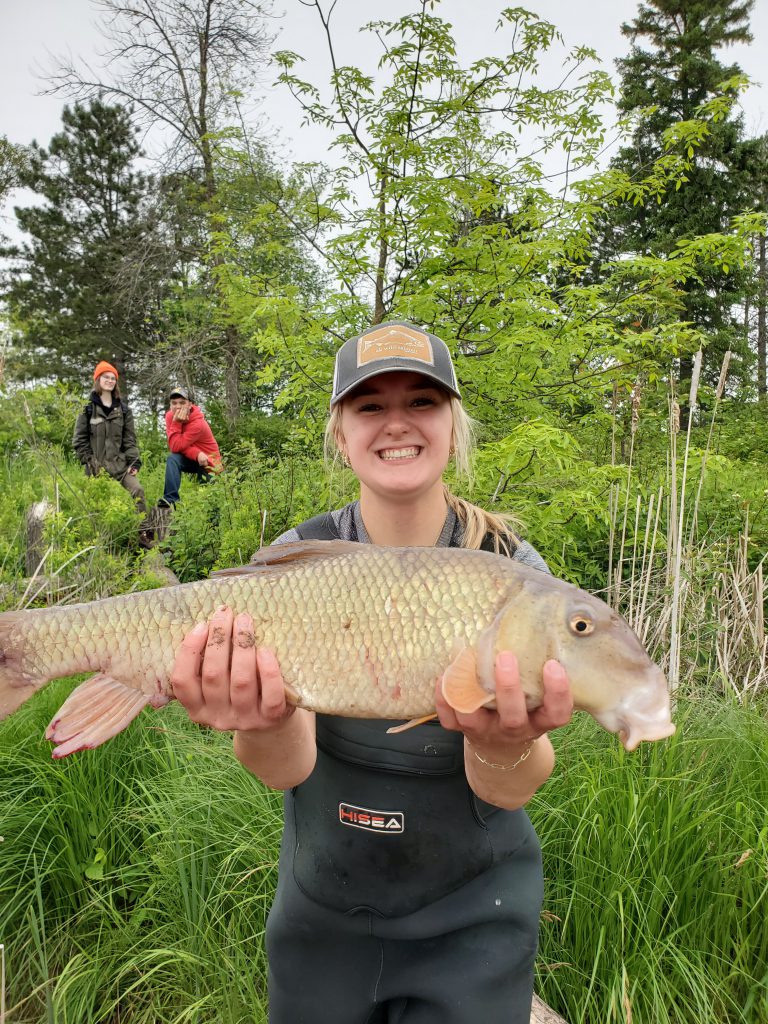
Environmental science major Brinley Tonn holds a large redhorse sucker. Photo by Lyndsey Krist.
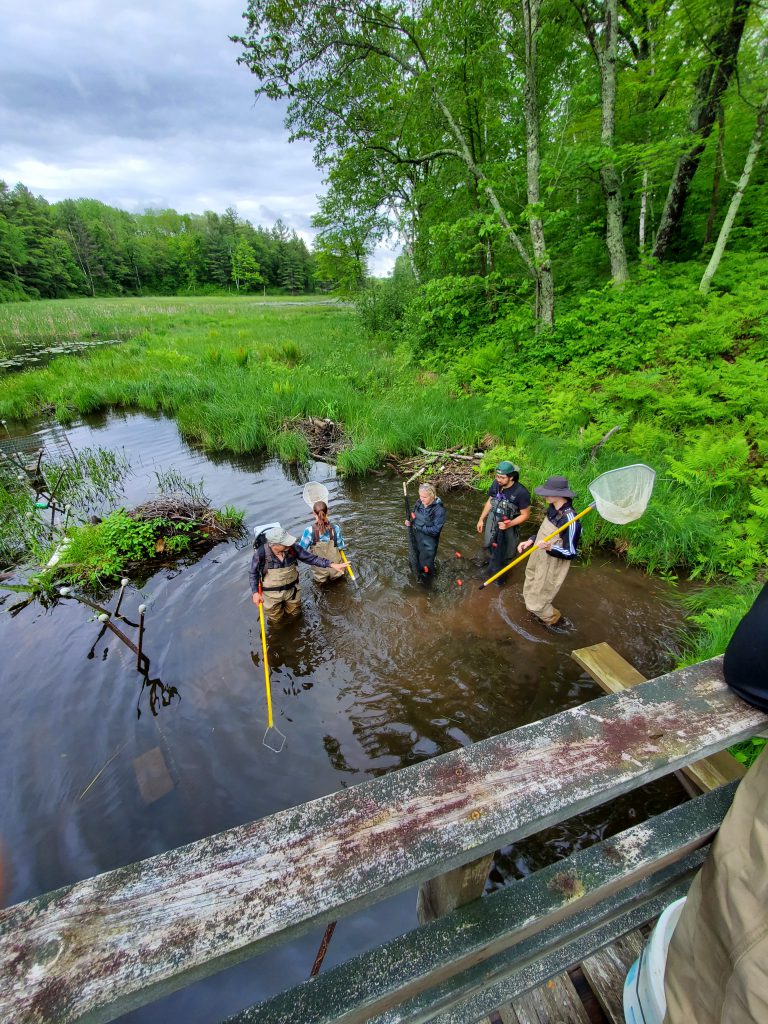
Students follow Professor Bessert into a bog to electrofish to survey fish. Photo by Lindsey Krist.

